Espresso and French press are the two most popular brewing methods when it comes to coffee. Both are very easy to prepare and provide a dark, strong brew you can enjoy throughout the day. However, they vastly differ in flavor. So, which of the two is a better option for you?
To make that decision you need to understand a bit more about how they are brewed, what kind of coffee you need to make each brew, etc. No worries, we have got you covered!
IN THIS ARTICLE:
Differences In Taste & Serving
Both espresso and French press are a type of coffee brew. However, they differ in the brewing method, brew size, strength, caffeine, flavor, etc. Let’s talk firstly about taste.
Serving Size
Espresso is a specialized type of coffee brew that has a more social note to it and is often enjoyed on special occasions. It is served as a 1 fl oz shot you drink in one or two sips. French press coffee, on the other hand, is more of an everyday brew you can easily make at a low cost. It is served as a 4 oz serving you can sip on for a while.
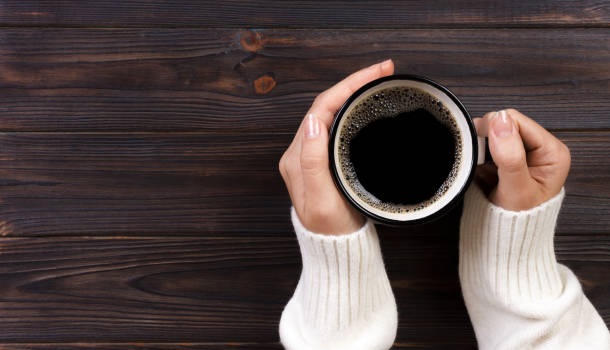

Caffeine Content
This is a question that comes up in every conversation: Which brew has more caffeine? To be honest, it is quite an unfair question. Espresso has more caffeine per volume than almost all coffee brews. It is served as a 1-ounce shot and contains about 6 to 65 mg of caffeine (in a single shot). French press coffee is served as a 4 oz serving which contains between 40 and 60 mg of caffeine.
Flavor
When it comes to the flavor, espresso has a much more intense and bolder flavor. This is the reason why it is served as a small shot and not a full coffee cup. Because of its strong flavor, it is a great base for lattes, cappuccinos, etc. French press, on the other hand, is more gentle and has an intricate flavor. Those who love it will tell you it is the best way to brew a cup of coffee. As the coffee grounds steep in the water, more and more flavor is let out. This is why its flavor depends solely on the flavor of the coffee beans you use.
Consistency
The French press has the consistency of regular black coffee and for that reason, it can come in as a handy substitute. On the other hand, espresso is much more concentrated and as a result, has a much thicker consistency.
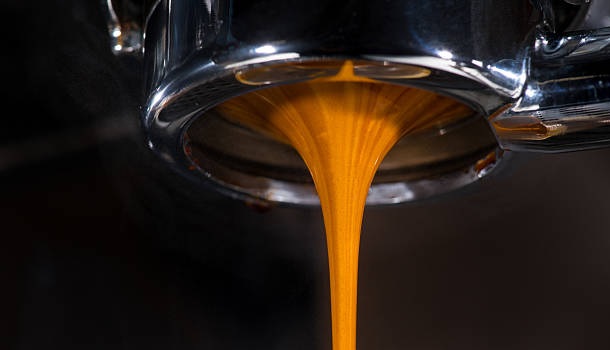

Crema
The “crema” everyone is talking about is a dark brown froth you get from brewing an espresso using an espresso machine. You get it because of the highly pressurized water that creates air bubbles or foam. It provides the brew with a much richer and full-bodied taste. This is not something you can get from a French press.
Is French Press Coffee Healthier?
Unfortunately no. French press is made without a paper filter so you might notice an increase in cholesterol levels if you consume too much of it. Research shows that drinking 5 cups of French press coffee daily per month resulted in 6 to 8% higher blood cholesterol levels. Using a large amount of it has even been linked to a higher risk of heart diseases.
Which Is More Acidic: Espresso Or French Press?
Espresso is generally less acidic as it is brewed using dark roast coffee beans (the more you roast coffee beans the less acidity they have). Knowing this, you can make a French press coffee using dark roasts too.
Difference In Beans
Finding the perfect coffee bean roast is essential to brewing a good cup of coffee or making the perfect espresso shot. So, what kind of roast works the best for each brewing method? Let’s find out:
…For Espresso
Now, you can use both Arabica and Robusta coffee beans to brew an espresso. Which one you choose depends solely on what kind of a flavor palette you want to get, a strong earthy one or a sweeter, more delicate one. Both have their pros and cons. Arabica beans are preferred because they offer much higher quality and are rich, sweet, and have slightly floral flavors. Robusta beans, on the other hand, make a richer crema we all want when ordering espresso.
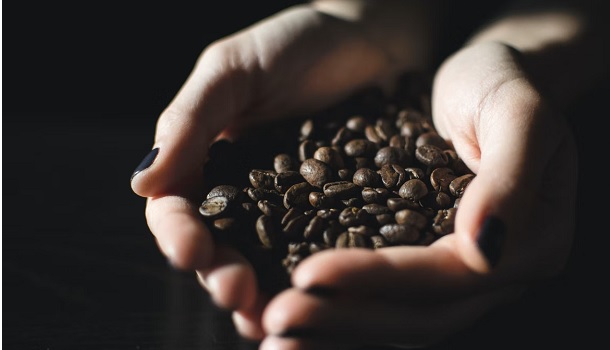

..For French Press
To make a French press your coffee needs to steep. This method brings out all the natural flavors from the coffee beans so, because of this, you want to make sure that you select high-quality beans. You can also use both Arabica and Robusta beans (you can even try some exotic options).
Grind Size
While you can experiment with different coffee blends, this is not true for grind size. If you get it wrong, you will not get the results you want. For espresso, your coffee beans need to be ground to a very fine consistency to ensure that the pressurized water that rushes through the coffee has some resistance. In case your coffee grounds are too coarse, the brewing time will be too short and the machine will not bring out the whole flavor pallet. Also, if you make a super fine grind, the water will not be able to pass through the puck, your coffee will burn, and you will get a bitter brew you won’t quite enjoy.
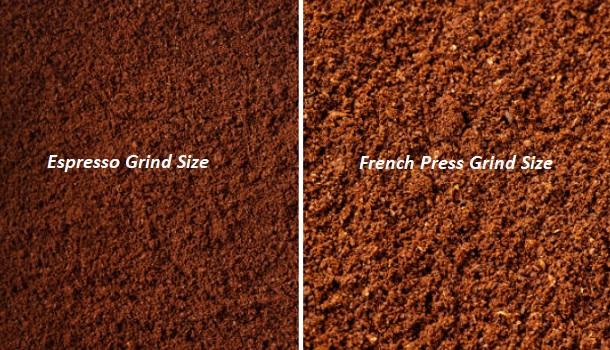

Now, for the French press, the opposite is true. This method is much slower so you want to use the medium to coarse grind size. If you use too coarse grounds, your brew will taste watery. If you use too fine a grind size, the filters inside of the plunger won’t be able to do their job, meaning, you will end up with small coffee particles in your brew.
Differences In Brewing Method
The most obvious difference between the two is the brewing method itself. While some may think that a French press is only a method you can use to make espresso, this is not true. These are two very different methods. Espresso is brewed very quickly using a high pressure whereas French press coffee is steeped over time.
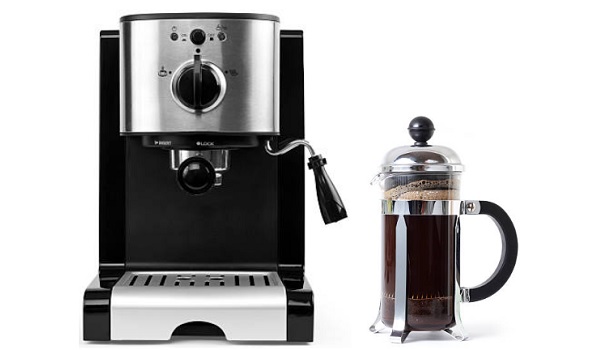

Simplicity
French press coffee is much easier to make than espresso. You only combine coffee and water and wait for the steeping process to complete. For espresso, on the other hand, all the brewing parameters need to align perfectly for you to get a rich brew.
Brewing Process & Efficiency
When using an espresso machine, you can get a perfect brew in only about 20 to 30 seconds. For a French press brew, you always need 4 minutes. Keep in mind that this is not counting the time you need to grind your coffee beans and heat the water/machine.


Brewing Capacity
An espresso machine is a must-have for everyone who truly enjoys espresso. However, you need to know that an espresso machine allows you to make only one shot at a time (two tops in case it comes with a double spout portafilter).
Now, a French press allows you to brew multiple servings at once. Exactly how much? This depends on the size of the press you buy. You can find 3 cups, 6 cups, 9 cups, and 12 cup presses. No matter which one you opt for, the brewing process always takes 4 minutes (this is because the coffee to water ratio is always the same).
Cost
Let us face it, espresso is much more expensive to make than French press. The entry-level espresso machines cost around 100 dollars while a high-end one might take you back as much as 5000 dollars. Now, if you do not drink espresso that often (more than once a day), there is no sense in investing in a machine. However, if you do, a good machine is worth investing in as it makes all the difference.
French press is a much more affordable option. Most models are made out of borosilicate glass and will set you back only 20 to 30 dollars. Even if you want a specially designed vintage one or a more durable stainless steel option, you won’t spend more than 100 dollars. If you are a newbie there is no need to invest in the more expensive option as the results are the same.
Is French Press Good For Making Espresso?
While a French press can come in handy as a brewing method when you do not own an espresso machine, it is probably the least effective method you can use. There is no pressure in a French press so you can not achieve the extraction process or the results it usually provides.
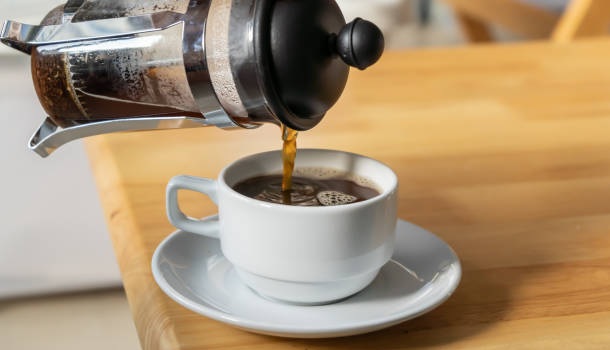

Why Is My French Press Coffee Bitter As Espresso?
Your French press brew can be bitter only if you put super-fine coffee grounds in it. To coarse grind will result in a sour brew.
Can I Use Fine Ground Coffee In A French Press?
You can, but you will not get the results you are looking for. The main reason to avoid this is that if you use a too fine grind, the filters will not be able to remove the small particles from your brew and your coffee will have a gritty texture.
More In Details About Espresso
Espresso is a very strong and concentrated type of coffee brew. To make it properly, you need to have an espresso machine that pushes highly pressurized water through the coffee puck inside the filter. Although it may sound complicated, this is a very quick process that efficiently draws out the perfect espresso flavor.
When Is Espresso The Best Option?
Espresso is highly caffeinated, and for that reason is the best to drink in the morning. The best thing about it is that you can use it as a base to make many different types of espresso drinks:
- ristretto, doppio, americano, lungo
- macchiato, cappuccino, latte
- flat white, cortado, Gibraltar
- affogato, espresso martinis
Benefits & Downsides Of Using The Espresso Method
The espresso brewing method provides you with a:
- the very quick and efficient brewing process
- strong delicious brew in the shortest time possible
- possibility of brewing versatile espresso-based beverages


However, its downsides are that:
- it provides you with a single serving at a time
- you need to pay attention to its cleaning process and maintenance
Espresso – The Most Basic Recipe
When you have a machine, espresso is super easy to make. Here is the most basic recipe that will provide you with a flavorful shot of coffee with every use:
The first thing you want to do is turn your espresso machine on and let it heat up. This can take anywhere from 5 to 30 minutes, it depends on what kind of a machine you have (refer to the machine's manual).
At this point, you want to grind your coffee beans. A conical burr grinder will provide you with the best results but any coffee or a spice grinder can come in handy.
Now, take the portafilter out from the machine, fill it up with 9 grams of coffee for a single espresso shot (18 for a double), and tamp it down using even pressure. Run some water through the brew group to ensure that you remove the leftover grounds from it from the previous brewing cycle. Place the portafilter back into its position and lock it in.
Start the brewing process. You will need only about 20 to 30 seconds to pull a perfect espresso shot with rich top crema.
Ingredients
Directions
The first thing you want to do is turn your espresso machine on and let it heat up. This can take anywhere from 5 to 30 minutes, it depends on what kind of a machine you have (refer to the machine's manual).
At this point, you want to grind your coffee beans. A conical burr grinder will provide you with the best results but any coffee or a spice grinder can come in handy.
Now, take the portafilter out from the machine, fill it up with 9 grams of coffee for a single espresso shot (18 for a double), and tamp it down using even pressure. Run some water through the brew group to ensure that you remove the leftover grounds from it from the previous brewing cycle. Place the portafilter back into its position and lock it in.
Start the brewing process. You will need only about 20 to 30 seconds to pull a perfect espresso shot with rich top crema.
You might need some time to balance the grind, tamp, and the duration of the brewing process. In case your brew tastes watery, add more coffee to the filter – use less if your brew is too bold. If the shot takes longer than 30 seconds to brew, either use a coarser coffee grind or reduce the amount of coffee.
“Plunging” Into French Press
Now, as opposed to the espresso which is brewed/extracted, the French press brew is made using the same name appliance. To make a powerful brew, you need to immerse coffee grounds in hot water that is near a boiling point for 4 minutes. Then, you need to plunge the grounds from the water and you get a perfect brew.
When Is French Press The Best Option?
A French press can be an amazing replacement for drip coffee, pour-over, and instant coffee. The great thing about it is that by using a press you can make several servings at once. It comes in quite handy when you have company over and you do not want to make one shot of coffee at a time.
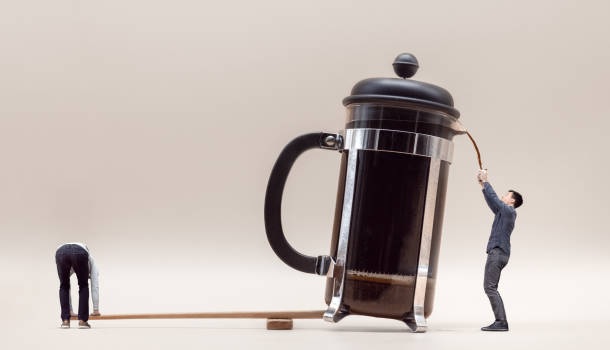

Benefits & Downsides Of Using The French Press Method
A lot of people love the French press brewing method and for a good reason:
- it allows you to make a larger batch of coffee at once
- you have complete control over the brewing process
- you can use it at home or while traveling
- is very easy to clean
- does not require any maintenance
- is a relatively cheap option
The only downsides of a French press are that:
- the brewing process takes much longer to complete
- you can only make one type of coffee – the French press
How To Make A French Press?
French press coffee is very easy to make. Here is a detailed recipe to ensure that you make a perfect batch of coffee with every single use. Keep in mind that this recipe is tailored to a 12-cup press. If using a smaller press you can adjust the ingredients accordingly.
The first thing you need to do is heat the water for the press using either an electric kettle or a stovetop pot. We recommend heating just a bit more than the 50 oz you need for the brew - this is to ensure that you can heat the press first.
Once the water heats up, pour the excess water into the press, swirl it around for a bit, and dispose of the water. By doing this you are ensuring that your brew stays at its optimal temperature level for a much longer time.
Now, add your coffee grounds into the press. For a full 12-cup press you can use about 12 to 14 tablespoons of coffee grounds. If you do not prefer that bold flavor, you can add less but your brew might taste a bit watery.
Pour the 50 oz of hot water over the grounds.
Assemble the coffee plunger and place it in its position atop the press. Push the plunger down so that the filter sits just above the water level.
Let the coffee steep in the press for 4 minutes and then press the plunger all the way down.
Ingredients
Directions
The first thing you need to do is heat the water for the press using either an electric kettle or a stovetop pot. We recommend heating just a bit more than the 50 oz you need for the brew - this is to ensure that you can heat the press first.
Once the water heats up, pour the excess water into the press, swirl it around for a bit, and dispose of the water. By doing this you are ensuring that your brew stays at its optimal temperature level for a much longer time.
Now, add your coffee grounds into the press. For a full 12-cup press you can use about 12 to 14 tablespoons of coffee grounds. If you do not prefer that bold flavor, you can add less but your brew might taste a bit watery.
Pour the 50 oz of hot water over the grounds.
Assemble the coffee plunger and place it in its position atop the press. Push the plunger down so that the filter sits just above the water level.
Let the coffee steep in the press for 4 minutes and then press the plunger all the way down.
When it comes to a French press, there are a couple of things you need to get right:
- water quality – filtered is the best option
- water temperature – between 195 and 200°F
- the grind size – it should be a medium grind
- coffee to water ratio – 1 tablespoon per 4 fl. oz.
- steeping process – always 4 minutes
Once you align all these parameters, you will get the most delicious brewing results.
Do You Have To Fill A French Press All The Way?
No, you do not. What you do need to do is adjust the coffee to water ratio properly. So, if you have a 6-cup press that can make about 24 oz of coffee at once and you want to brew only 2 servings, use 8 oz of water and 2 to 3 tablespoons of coffee. Keep the plunger above the water’s surface and press it all the way down once the 4 minutes run out.
To Wrap It Up
As you can tell for yourself, espresso and French press coffee are two very different types of brew. Espresso is made using a pressurized extraction process, dark roast coffee beans, and a very fine grind size. As a result, you get a strong brew with a thick consistency and bold flavor. French press coffee is steeped rather than extracted, you can brew it using lighter roasts as well as the darker ones and a medium to coarse coffee grind. The flavor palette is a bit lighter so you can sip on it for a while.

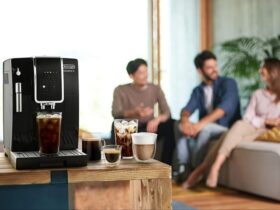










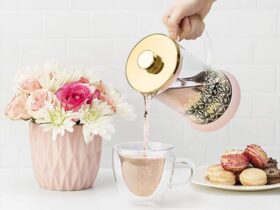
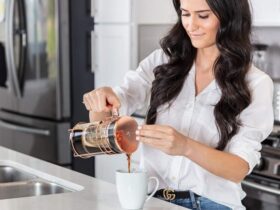
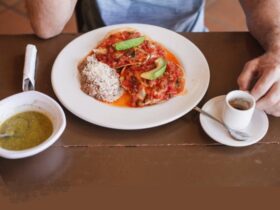




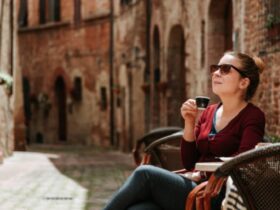
Leave a Reply